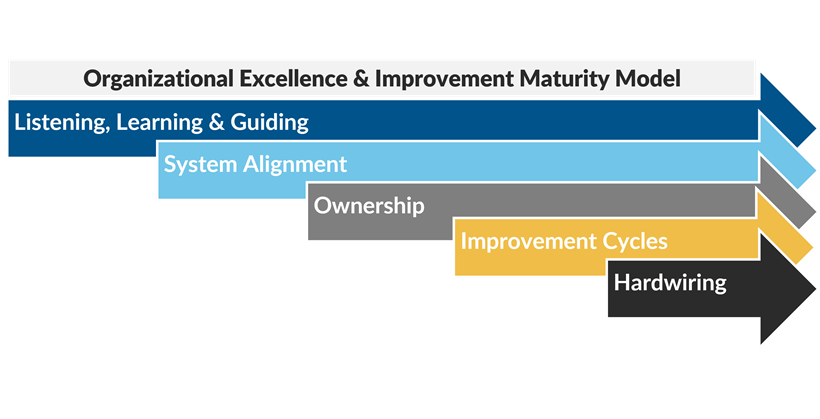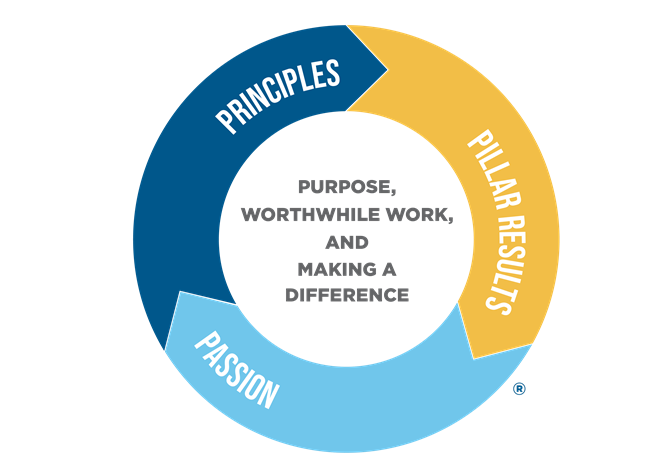In Brief
The American Society for Quality defines organizational excellence as “systematic efforts to establish a framework of standards and processes intended to engage all employees to deliver value in the products and services that fulfill customer requirements.” It is more critical today than ever for K12 systems to define what organizational excellence looks like in their system and have a concrete roadmap to achieve it.
Summary
- The Improvement Maturity Model provides a roadmap segmented into five phases to help leaders drive continuous improvement cycles.
- A standardized model to guide improvement can help education leaders embed values, development and data into all decisions and actions behind strategic priorities.
- Intentionally focusing on culture alongside strategy is necessary to success in any organizational excellence journey.
What is the Improvement Maturity Model?
The Improvement Maturity model provides a five-stage framework to help leaders and teams visualize their excellence journey. It outlines a process that leaders can implement to attain a culture of excellence. For high-performing organizations, this pursuit of excellence is never-ending. School systems are facing constant change. The programs and processes that fulfill employee and student needs today are different than what they may need soon.
We now accept the fact that learning is a lifelong process of keeping abreast of change. And the most pressing task is to teach people how to learn.”
— Peter Drucker
Schools that are considered excellent today could fall behind if they don’t have a method for looking into the future to define what excellence looks like tomorrow. Managing the pace of constant change calls for organizations to constantly improve and innovate. To sustain excellence, people in the organization must avoid becoming complacent.
Organizations achieve excellence when leaders create the right goals, with the right accountability and continuously develop people through cycles. The Improvement Maturity Model helps leaders focus on the right combination of culture and strategy to sustain excellence.
Breaking Down the Five Phases of the Maturity Model
We can use this model to reflect changes in our people, culture and processes throughout our excellence journey. Rather than assess where the organization is in each phase overall, some teams may find it helpful to rate themselves based on each characteristic within the model. Within a phase, an organization will likely find both strengths and opportunities for improvement.
Each phase is broken down by the guiding characteristics that define it:
Phase 1: Listening, Learning and Guiding
Guiding Characteristics:
- Listen deeply and gather feedback.
- Engage in leader self-reflection.
- Set future goals and strategic aims.
- Prioritize leader development to build capacity.
- Begin core tactics training on leadership fundamentals to build leadership skills and confidence.
The core purpose of this phase in the model is listening. Leaders learn the most when gathering feedback from those closest to the work. For leaders to improve, they must collect feedback about their own performance, about where others in the organization need support and from external audiences.
By listening and engaging in self-reflection, leaders can set strategic aims and begin to guide teams in the right direction. They will likely identify both gaps in processes and performance gaps within the people on the team through listening.
An organization is a group of people working towards the same goal. Without improving the capacity of the people, the organization can’t improve. As leaders set strategic aims and guide teams, they should also prioritize leader development to advance the skills of all employees.
At the very beginning of an improvement cycle, start training people on tactics and fundamentals that help all employees advance with the organization.
Phase 2: System Alignment
Guiding Characteristics:
- Engage leaders at every level to define core values and aligned behaviors.
- Develop a strategic direction to define organizational excellence to adapt and adjust to continuous change.
- Align measures that matter to strategic priorities to scaffold scorecards.
- Deploy ongoing development to increase individual capability and systemic capacity.
This phase underscores the combination of culture and strategy at work. Part of the phase deals with values and behaviors, while the other is entwined in strategy and data. To contribute to excellence in an organization, employees need a clear understanding of what it is and how they will get there. It’s not enough to say “we will provide amazing service”. Leaders should be explicitly clear about what the standards for amazing service are.
In this phase of maturity, an organization defines core values and the associated behaviors that demonstrate those values in action. These standards of practice let people know what to expect and what is expected of them. The strategic direction should reflect the values of the organization. Measures aligned to strategic priorities can be monitored and communicated using a scorecard tool. This alignment and transparent communication of progress provides a clear focus, so people know what matters most. As people, processes and systems get aligned, the development of leaders and employees continues to increase individual and systemic capacity.
Phase 3: Ownership
Guiding Characteristics:
- Align feedback processes to core values.
- Align hiring and onboarding to core values and aligned behaviors, and priorities for organizational excellence.
- Align individual and team goals to priorities for organizational excellence and scaffold scorecards to department level.
- Engage in self-reflection, individual development goals, and ongoing coaching conversations.
- Celebrate progress.
- Commit to strategic priorities aligned throughout the organization.
- Scaffold communication for aligned improvement.
- Transparently share information and data.
Continue building on those core values in this phase of the model, focusing on the aligning feedback, hiring and onboarding processes to the organization’s values. Because there is clarity of standards, process and priorities, departments can better align their goals and individual actions to the measures of the entire organization.
By using a scorecard tool to document and track progress within departments as it aligns to the overarching strategy, leaders can share information and data transparently. Frequent, transparent communication keeps people committed, motivated and aligned. It also presents ample opportunity to celebrate progress and recognize individual contributions. Through the nature of recognition, people become owners of their work, seeking solutions rather than bringing problems to their manager.
Phase 4: Improvement Cycles
Guiding Characteristics:
- Prioritize improvement teams for system learning and improvement.
- Lead 45-90 Day Improvement Cycles.
- Transparently use and share information and data
- Pause to reflect on progress, celebrate learning and refinement in order to prioritize next actions from review of data and feedback.
- Execute on learning.
- Ask key questions aligned to progress toward big aims.
- Manage individual and organizational performance aligned to priorities.
At this phase, there are several improvement fundamentals in place and being practiced at all levels of the organization. People in organization are doing more than “improvement work”, they have developed an improvement mindset. There are aligned values, behaviors and goals to focus on.
From here, leaders can begin to prioritize specialized teams for system learning and improvement cycles. Using 45–90-day cycles, team leads gather information, define success, identify possible root causes and determine success measures. Each team continuously monitors progress and leans on the data to determine next steps.
Again, it’s important to keep people motivated by pausing to celebrate progress and reflect on learning. This allows us time to refine the next cycle based on data and feedback. Here leaders also continue to manage and refine individual performance and priorities. What individual responsibilities are the most beneficial to the organization? What skills can people continue to develop to help the organization achieve excellence?
Phase 5: Hardwiring
Guiding Characteristics:
- Routinely reflect on learning and progress.
- Scale what works and refine what doesn’t constantly adapting to continuous change.
- Routinely align improvement cycles to gaps in attaining the strategic priorities based on stakeholder needs and annual reflections on progress toward the measures-that-matter and the key questions aligned to attaining the big, multi-year aims.
- Sustain aligned development. feedback, communication and routinely refine core processes aligned to goals.
- Monitor individual and organizational performance to achieve the mission, vision, and demonstrate evidence of sustained individual and organizational excellence.
Learning is a lifelong process. Part of becoming an excellent organization is hardwiring routine reflection on learning and progress. Through improvement cycles, leaders can learn what works and refine what doesn’t. It creates a foundation for adapting to unexpected changes and continuously identifying barriers to achieving priorities. The work is focused on progress toward the measures that matter and the future needs of the employees, students or customers each team serves.
This phase focuses on improving and sustaining every characteristic of the maturity model. Organizations who have reached this phase are aligning development to continuous learning and the strategic aims of the organization. Communication is clear and focused on priorities. The processes that enable people to do their best work aligned to their goals are in place. Progress and performance is monitored and tracked to demonstrate evidence of sustained individual and organizational excellence.
Where an organization falls on the model is fluid. Although the model appears to be linear in progression, the implementation of the phases are continuous. The maturity model evolves as the organization gets results and experiences change in the internal and external environment. Sustaining excellence only happens when the organization continuously analyzes the current status and future aims. It begins by determining where teams are within each stage. Then, start with one to two areas to improve.
Combining Culture and Strategy
The maturity model for excellence is a strategy that provides a simplified perspective on a complex journey. What drives behavior from day-to-day changes and is deeply influenced by the culture in an organization. That’s why the right combination of culture and strategy is critical to maintaining momentum. Rather than view the phases as easier to harder, it’s helpful to view each phase in relation to the Organizational Excellence Flywheel, which outlines the driving forces behind continued momentum: principles, pillar results and passion.
Principles
The Nine Principles® for Organizational Excellence are the guiding concepts of Evidence-Based Leadership. When applied consistently, these principles combine culture and strategy to sustain excellence. These principles set the behaviors and expectations required to create a culture of high-performing individuals aligned to the vision.
Pillar Results
What matters most to the team? What does success look like? A pillar is a big picture area to focus on. Pillars align to the mission and vision of the organization. Common pillars in school systems include student success, service or finance. Pillars help communicate the goals and metrics used to measure success.
Passion
People want to do worthwhile work that makes a difference. They also want to feel appreciation and value for their contributions. Employees are motivated when they understand how what they do matters. Purpose is embedded within the culture of excellent organizations. Everyone’s vision aligns to the outcomes they help create to benefit another. Leaders who commit to communicating the organization’s purpose as often as sales goals and profits have more highly engaged and satisfied employees. Gallup’s findings conclude that even a moderate improvement in employee connection to purpose would reduce turnover and increase profitability.
Progression through the Improvement Maturity Model indicates that the flywheel is beginning to spin faster. As the organization commits to cycles of improvement, the team’s momentum builds. This is how organizations mature within their excellence journey.
KEY TAKEAWAYS
-
Think differently.
Understand the relationship between culture and strategy in maintaining momentum and view excellence as a continuous journey. -
Plan differently.
Use the phases of the Improvement Maturity Model to assess where the organization is strong and where there are gaps and use that information to plot a roadmap for improvement. -
Act differently.
Embed core values into the strategy, behavior and goals of the organization.


